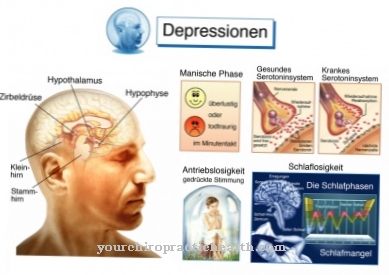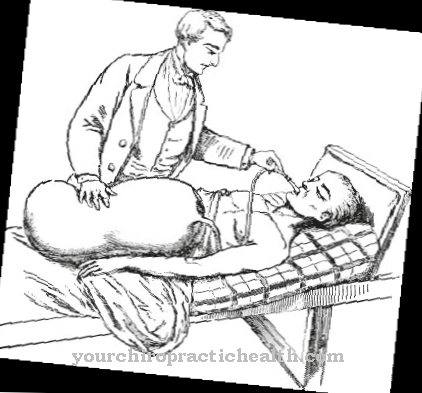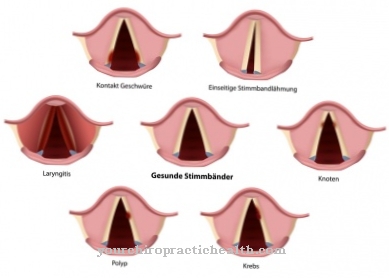In which Pfeiffer syndrome it is an autosomal dominant hereditary disease. This is very rare and shows abnormalities in the bone formation of the face and skull. Pfeiffer syndrome is caused by a mutation in certain proteins that are responsible for the maturation of bone cells.
What is Pfeiffer Syndrome?

© Rasi - stock.adobe.com
The Pfeiffer syndrome is a rarely occurring hereditary disease that is one of the craniosynostoses. Since this is inherited in an autosomal dominant manner, people with this disease have a fifty percent chance of passing it on to their children. Pfeiffer syndrome impairs the normal growth of the skull and facial bones, leading to craniofacial abnormalities. The bones fuse early and affect the shape. The bones of both hands and feet are also affected by the abnormal growth.
The failed fusion of the facial bones leads to bulging and wide-open eyes, a high forehead, a flat bridge of the nose and an underdeveloped upper jaw. Clinically, a distinction is made between three types. The three types have differently pronounced characteristics. Patients with types 2 or 3 are more severely affected and life expectancy is noticeably reduced. The exact prevalence of Pfeiffer syndrome is not known, and it is estimated to be 1 in 100,000 people worldwide. This disease is caused by a mutation in the genes FGFR-1 and FGFR-2.
causes
Pfeiffer syndrome results from a mutation in the genes FGFR-1 and FGFR-2. This mutation is inherited as an autosomal dominant trait. If either parent is affected by this mutation, there is a fifty percent chance they will pass it on to the child. These genes are responsible for the production of important proteins, the fibroblast growth receptors 1 and 2 (fibroblast growth factor receptors). Type 1 of Pfeiffer syndrome can be caused by a mutation in one of the two receptors. Types 2 and 3 are caused by a mutation in the FGFR-2 gene and are not associated with a change in the FGFR-2 gene.
The proteins perform many important functions. During embryonic development, they signal immature cells to develop into mature bone cells. A mutation in one of these genes changes protein function and causes prolonged signaling. This lengthening promotes the premature fusion of the skull and facial bones. The normal development of bones in the hands and feet is also affected. This leads to the main characteristic features of Pfeiffer syndrome.
Symptoms, ailments & signs
The premature fusion of certain skull bones leads to the characteristic facial deformations of Pfeiffer syndrome: the eyes are bulging and wide open and the distance between them is increased. The forehead is clearly defined, the ears set deep and the midface underdeveloped. The skull is flattened and short. More than half of all patients complain of hearing loss and dental problems.
Most of the time, the toes and fingers are unusually short, with some fusions in between. The big toe and thumb are strikingly short, triangular in shape and curve away from the other toes and fingers. Depending on the clinical type, the symptoms vary in severity. Type 1 is the classic form of Pfeiffer syndrome. This is milder than the other two types. The affected person has a normal intelligence, slight deformation of the fingers and toes and a slight expression of a midface hypoplasia.
Type 2 has more severe clinical symptoms. The skull is shaped like a shamrock and the eyeballs protrude noticeably from the eye sockets. Anomalies in the fingers and toes are very pronounced. Also deform the elbows. The bones are often awake and stiffen spontaneously. Neurological complications also occur. The development of the affected child is delayed. Type 3 of Pfeiffer syndrome develops the same symptoms as type 2, but without the cloverleaf skull.
Diagnosis & course of disease
Pfeiffer syndrome can be diagnosed as early as the third month of pregnancy during embryonic development. A prenatal examination can use a fine ultrasound to reveal an abnormally large distance between the two eyes. The pathological protrusion of the eyeballs from the eye sockets as well as deformations of the skull and face area can also be determined. After the birth, the exact diagnosis is guaranteed with a genetic test.
Complications
In most cases, those affected by Pfeiffer syndrome suffer from various malformations and deformities. These primarily have a very negative effect on the aesthetics of those affected, so that most patients feel uncomfortable with them and suffer from inferiority complexes or from a reduced self-esteem. Depression can also occur due to Pfeiffer syndrome and significantly reduce the patient's quality of life.
Pfeiffer syndrome also leads to hearing loss that occurs gradually. Tooth problems or tooth loss can also occur and make it difficult to take food and fluids. Furthermore, the patients suffer from anomalies of the toes and fingers, so that there may be restrictions in everyday life and restricted mobility in the patient.
The mental development of the child is also significantly delayed due to the Pfeiffer syndrome, so that the patient is dependent on the help of other people in adulthood. Surgical procedures can remove some of the abnormalities. There are no complications. However, the patient is still dependent on various therapies and support measures in order to be able to cope with everyday life.
When should you go to the doctor?
Children suffering from Pfeiffer syndrome require intensive medical care from birth. The malformations on the head and limbs must be corrected surgically. In addition, the affected children usually need pain relievers, anti-inflammatories and other medicines. Parents should contact a specialist immediately after delivery so that a comprehensive diagnosis can be made. The actual treatment takes place in specialist centers.
Specialists from the fields of oral and maxillofacial surgery as well as neurosurgeons and plastic surgeons are responsible. In addition, close consultation with the pediatrician must be held. After the initial therapy, the doctor should be visited regularly so that the medication can be stopped and the various surgical wounds examined for complications. Since Pfeiffer syndrome leads to major visual flaws, which often also stress the child mentally, therapeutic advice can also be useful. If the outcome is positive, however, the main characteristics of the disease can be reduced to such an extent that normal life is possible without therapy and regular doctor visits.
Therapy & Treatment
Depending on the severity of the Pfeiffer syndrome, surgical correction of the face and skull can be carried out. This is possible through facial, oral and maxillofacial surgery as well as plastic surgery and neurosurgery. By expanding the frontal-orbital skull area, the skull can grow properly and the size of the eye sockets can be increased.
The jaw and midface can also be corrected by a surgical procedure. With fair treatment, sufferers can develop normal intelligence and lead normal healthy lives. The treatment plans are carried out in stages. The right time to carry out a bone structure reconstruction is very important. Accordingly, the devastating effects of Pfeiffer Syndrome on the ability to breathe, speak and swallow are prevented.
Due to the underdeveloped midface, children often suffer from obstructive sleep apnea. For mild sleep apnea, drug treatment can improve breathing intensely. However, a severe breathing disorder should be monitored by specialists. Surgical removal of the tonsils or a continuous airway pressure mask (CPAP) can alleviate the symptoms.
Outlook & forecast
To specify a prognosis, the type of Pfeiffer syndrome present must be determined. The severity of the deformities associated with Pfeiffer syndrome has led to the division into three types with different prognoses. In the classic Pfeiffer syndrome, the deformations are only mild. The intelligence is not diminished. The prognosis is good, especially since the existing deformities can be reduced surgically.
The prognosis for Pfeiffer syndrome is not so optimistic. The deformations are much more serious. The so-called shamrock skull is typical. The deformities on the skeleton are partly operable, but mostly not correctable. Mental development is delayed. Neurological complications are to be expected.
In the third Pfeiffer syndrome, the symptoms are similarly serious, only the clover-leaf skull is missing. Here, too, the prognosis is not particularly good due to the genetic cause. The flowing transitions between the three Pfeiffer syndrome forms make a clear demarcation and prognosis difficult.
However, it is helpful that the presence of Pfeiffer syndrome can be determined prenatally. The typical deformations are already apparent during sonography. In addition, there is an increased risk of these genetically inherited mutations known in individual cases. Whether a legal abortion is then still possible or whether it is considered by the family varies. Once the child is born, they usually have several operations ahead of them.
prevention
Since Pfeiffer syndrome is an autosomal dominant inherited disease, it cannot be prevented. However, it can be diagnosed before birth.
Aftercare
In most cases, those affected have few or even no special follow-up options available for Pfeiffer syndrome. First and foremost, a very quick and, above all, early diagnosis of the disease is important so that no further complications can occur. Self-healing does not occur, so that the person affected should ideally consult a doctor at the first symptoms or signs of the disease.
Since this is also a genetically determined disease, if the patient wants to have children, he should definitely have a genetic examination and advice carried out in order to prevent the recurrence of Pfeiffer syndrome. Most patients are usually dependent on surgical interventions that can alleviate the symptoms.
The person affected should definitely rest after such an operation and take care of their body. Exertion or physical and stressful activities should be avoided in any case in order not to unnecessarily burden the body. Likewise, most of those affected by Pfeiffer syndrome are dependent on the help and support of their own family in their everyday life, which can have a positive effect on the further course of the disease.
You can do that yourself
Pfeiffer syndrome is treated as part of a combination therapy, the aim of which is to alleviate the physical symptoms and the mental and emotional side effects. The parents of sick children can support the therapy by encouraging and supporting the child.
Since the malformations can lead to bullying and teasing and, as a result, to the development of social fears in those affected, it is all the more important to strengthen the child's self-confidence. Parents should also try to find a suitable kindergarten and school place at an early stage. In a facility for special children, a child with Pfeiffer syndrome can develop optimally and the parents can concentrate on receiving treatment for the physical complaints. Since it is not possible to completely correct the malformations, the apartment must be adapted for disabled people. The children also need aids such as walking aids or a wheelchair. The legal guardians should contact the respective specialists at an early stage and initiate the necessary measures.
In addition, therapeutic advice for parents and children can be useful. Later in life, a visit to a specialist clinic for hereditary diseases is also recommended, as the child will sooner or later ask questions about their illness. Then the relatives should be on hand with advice and action.

.jpg)


.jpg)



.jpg)



















